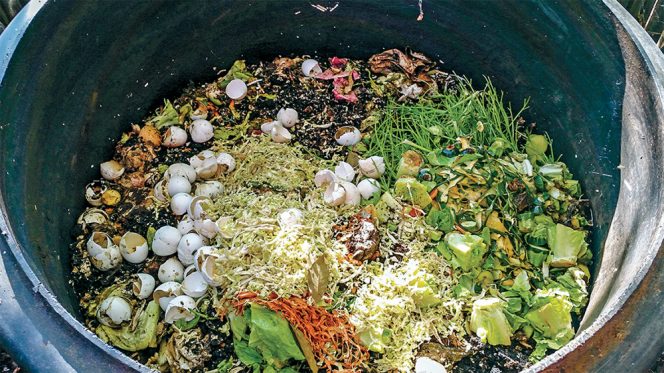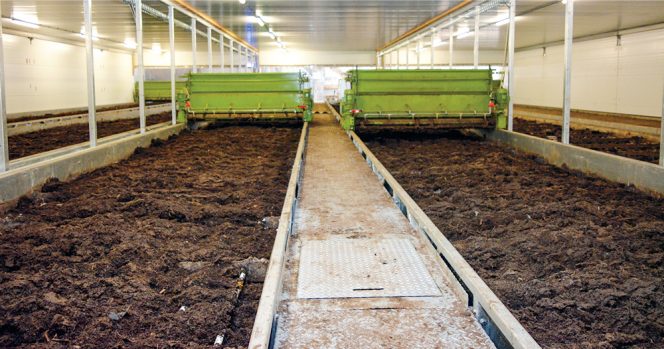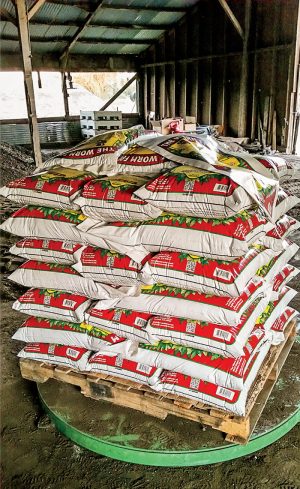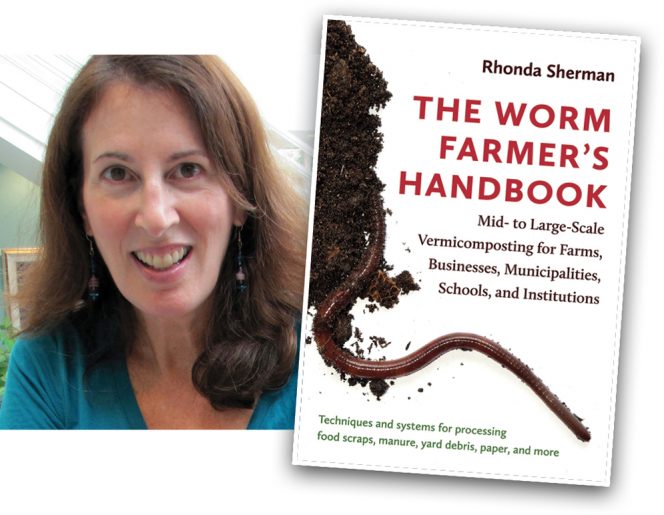The Worm Farmer’s Handbook “weaves the practical with the technical, science with art, and small-scale with large-scale exceptionally well,” writes our reviewer.
Richard Flammer
BioCycle November/December 2018
“The publishing deal came about when a senior editor at Chelsea Green emailed asking if I would consider writing a book on worm farming,” Sherman recalls. “The editors had noticed that there weren’t any books on that topic. Coincidentally, I had been wanting to write such a book for the past few years and finally felt that the time was right to do it.”

Bishop’s Ranch in Healdsburg (CA) — one of the case studies in the Handbook — has worm bins made out of sections of plastic culvert pipe. Each bin is fed 20 lbs/week of food waste, or about 3 tons in total annually. Photo by Rhonda Sherman
Sherman discusses these impressive staples of her ascent as a leading authority and educator on vermicomposting in the Worm Farmer’s Handbook. “My goal in writing this book is to provide unbiased, experience-proven information about how to produce vermicast for profit or to manage waste produced by farms, community gardens, municipalities, businesses, institutions, and industries,” she says.
And her aim is to truly help those interested in this resource management endeavor, providing practical guidance on establishing a vermicomposting business. “Too many people rush into worm farming with very little knowledge and no realistic plan,” Sherman explains. “They read some online articles and watch some videos, and decide they know enough to start a worm farm. Often this information is inaccurate or misleading, and by following it you may fail to succeed. I offer my best advice about how to avoid common causes of worm business failure, and cover regulatory issues as well as how to prepare a business plan and a separate marketing plan.”

Gantry feeders ride the top edges of continuous flow-through bins at PUR VER in Belgium to distribute feed to the worms. Photo courtesy of Alexandre Meire
Case Studies
Sherman’s advice is based on dozens of real-life experiences from vermicomposting operators. Their detailed stories in the Handbook are replete with business development progression, financial data, processing technology, and end product marketing. Some of these stories support various sections throughout the book, and others appear in the chapter entitled “Vermicomposting Operations Around the World.”

The Worm Farm in Durham (CA) began with an initial purchase of 100 pounds of earthworms that owners Mark and Arlita Purser put in their bathtub. Today, the business has several million dollars in sales annually (pallets of bagged vermicast above). Photo by Rhonda Sherman
• Noke Ltd., which “has billions of earthworms processing more than 220,000 tons/year of organic waste at worm farming operations in Taupo, Tokoroa, Maketu, and Pinedale (Putaruru) in New Zealand. Their largest worm farm at the Pinedale site in Putaruru covers 62 acres…”
• Grupo Aldea Verde, which has developed more than 70 vermicomposting operations in Mexico and other Latin American countries.
• Green Organic Agricultural Production Company, a woman-owned organic materials recycling facility and the first commercial composting company in Afghanistan.
• PUR VER (pure worm in French) in Belgium, whose founder Alexandre Meire, working with Agro-Bio University in Gembloux, designed and built two prototypes of continuous flow-through reactors, which have now been commercialized and produce more than 250 tons of vermicast annually.
The Worm Farm in Durham, California is among half a dozen successful U.S. vermicomposting businesses highlighted in the case studies chapter. It began with an initial purchase of 100 pounds of earthworms that owners Mark and Arlita Purser put in their bathtub (the worms subsequently escaped and died). The Pursers learned from that lesson and many others along the way to build an enormously successful business with 1.5 miles of vermicomposting windrows and several million dollars annually in sales. The Worm Farm was featured on CNBC’s Blue-Collar Millionaires television show in 2015.
Vermicast
Equally fascinating are the chapters on earthworms and benefits of vermicast to soils and plants. Growth trials and lab studies presented make an impressive argument for vermicast, and include Sherman’s own trials, literature reviews, and that of her friend Dr. Norman Arancon, professor of horticulture at the University of Hawaii, who has studied earthworms extensively. “Dr. Arancon has conducted a tremendous number of scientific studies on how vermicast affects plant growth and suppresses diseases, arthropod pests, and parasitic nematodes,” writes Sherman. His studies have shown, largely due to hormones and beneficial microbial populations, “seedlings germinate and plants flower two weeks earlier if they are grown with vermicast.”
The Worm Farmer’s Handbook is indeed bound to be an incredible resource for existing and prospective vermicomposters. A detailed, fully comprehensive guide, the handbook covers myriad topics organized in logical progression and written in a friendly, easy-going style. Sherman weaves the practical with the technical, science with art, and small-scale with large-scale exceptionally well. The result is an engaging, fascinating foray into all things vermicomposting. Or is it vermiculture? Sherman covers that. Worm castings, vermicompost or vermicast? The reader learns the difference. Scientific studies support the agricultural value of vermicast, highly successful vermicomposting operators share what works and what doesn’t, and Sherman’s own viewpoints and experiences in the text personalize and humanize the enormous breadth of data presented that makes a compelling case for the potential of earthworms and vermicast to continue its crawl towards becoming a commercial, resource management and agricultural powerhouse.
Rich Flammer of Hidden Resources, a BioCycle Contributing Editor, is a composting and zero waste consultant (www.compostingconsultant.com).











